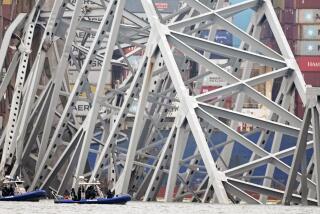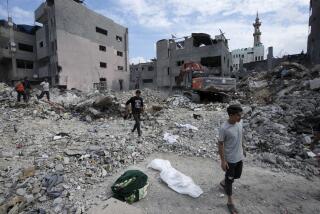The Rage and Anger
- Share via
NEW YORK — As the rain fell and the dust around the World Trade Center turned to mud early Friday morning, thousands of volunteers and rescue workers were forced to stop picking up the pieces and face their rage.
So much metal. So much death. And so little hope, days after two commercial airliners slammed through the symbols of America’s financial center and devastated a nation.
“There could be people inside, but I don’t think so,” said Carin Lockwood, 32, a volunteer who spent hours handing out dry towels to wet firefighters. “God, I want there to be people alive inside. I want to kill the people who did this.”
There is little she can do at this moment, because of the rain.
Welders turn off their equipment and run for shelter. Telephone crews pack up, just for a moment, while the firefighters continue to push on, armed now with only shovels and gloved hands.
Most people wait, finding shelter in the lobby of a condemned building and watching the progress through windows framed in shards of glass.
As the wind picks up, paper debris swirls above their heads and carpets the ground, ghostly reminders of a past life:
A canceled check from T&T; Enterprises for “a great job.” A deposit slip, dated Sept. 11, that was never taken to the bank. A repair to-do list for the north tower’s building crew, including instructions to plug a leak by an elevator and to replace a ceiling tile in the concourse hallway.
The papers are constant reminders of a week everyone wishes they could forget--the trauma of losing an icon, of knowing their loved ones suffered, of watching this grave being slowly uncovered.
But the shock of what these volunteers have seen has since worn off. In its place is rage toward the people responsible for killing their friends and lovers, their families and children.
“I wish I knew who to hate,” said David Costello, a welder who has spent the last 60 hours working at the World Trade Center site. “This doesn’t happen in our city. Terrorism happens other places.”
But the terror did come here. What used to be the home of artists and Fortune 500 companies alike is now a mountain of steel and asbestos atop a mass grave.
The building’s steel skeleton warps outward, fencing in the destruction. Blood-stained tiles litter the ground, joined by shards of desks and computers from offices that used to sit more than 100 stories in the air. Children’s drawings--some brought in by the firefighters, some taken from the grave--cover the walls of one rescue center, where a medical team washes the grime out of the firefighters’ and police officers’ eyes.
The rain continues to fall, making the search for survivors all the more dangerous.
“You never know when a section is going to slide away, or another building fall down,” said paramedic Danny Lockwood, who rested against a concrete pole as the rain left streaks of mud on his cheeks. “All these buildings around here, they’re all ready to go.”
Yet the people always return, unable to stop looking at the wreckageand the buckets that litter this gray metal mountain.
The buckets are meant for “hazardous materials,” says one doctor. Now, however, they serve as temporary caskets for victims’ remains.
Behind the doctors, hundreds of boxes filled with black body bags sit, waiting. Right now, the medical crew doesn’t need the bags; the buckets are enough.
The rain continues to fall. The streets are flooding. It’s 4 a.m. Friday and many of the rescue workers are tired and cold. Warmth, particularly for the battalions of wet rescuers, is key.
At the World Financial Center building, in the shadow of the wreckage, the once-chic shops and restaurants now stand wide open, and become impromptu bedrooms.
Inside one furniture shop, a dozen firefighters--from various battalions in the tri-state area--sleep on leopard-print couches and white linen chairs.
More to Read
Sign up for Essential California
The most important California stories and recommendations in your inbox every morning.
You may occasionally receive promotional content from the Los Angeles Times.













